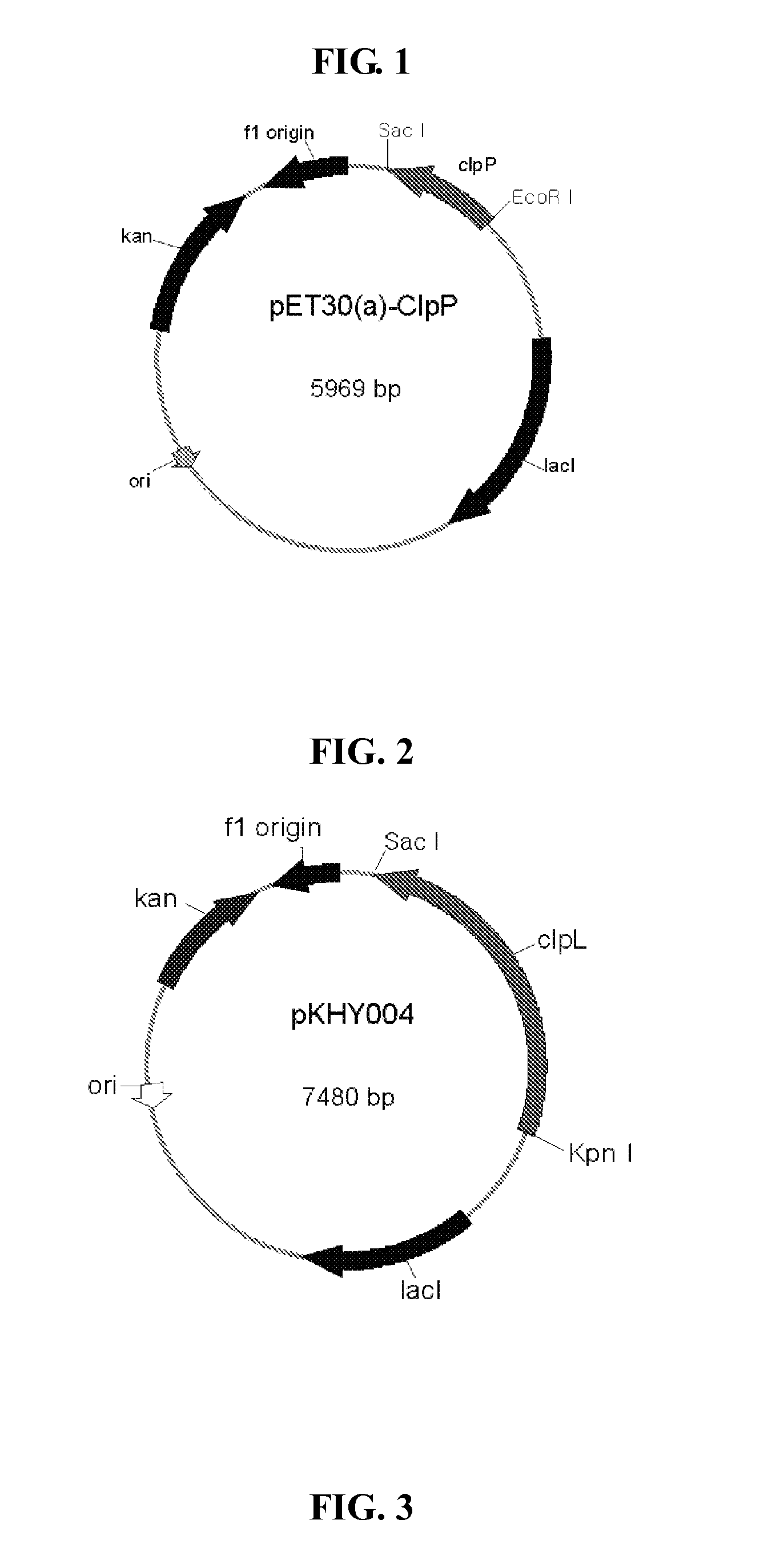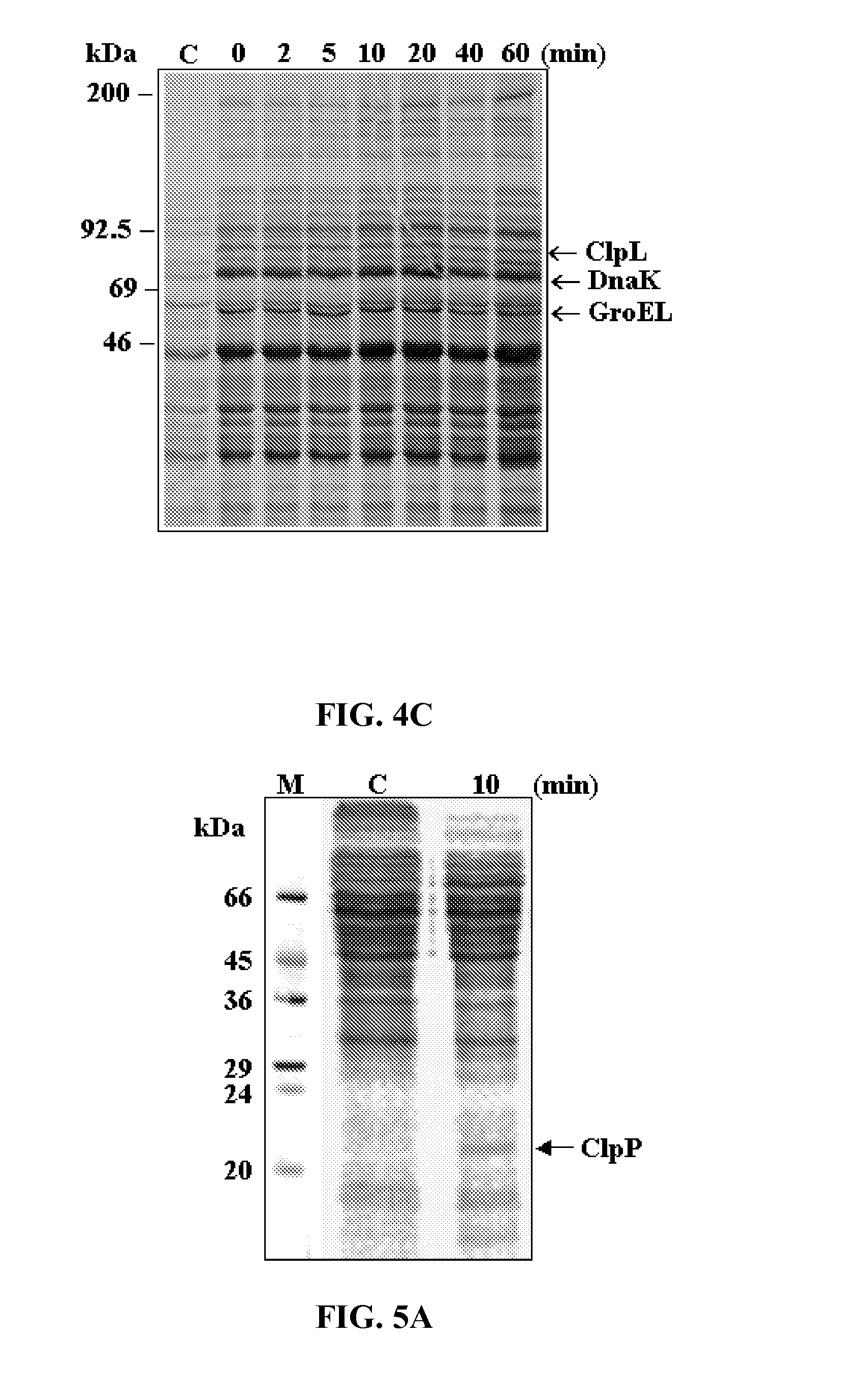Vaccine comprising recombinant clpp protein of streptococcus pneumoniae
a streptococcus pneumoniae, recombinant technology, applied in the direction of antibacterial agents, pharmaceutical active ingredients, antibacterial agents, etc., can solve the problems of difficult to treat infections caused by i>streptococcus pneumoniae /i>using antibiotics, the toxicity of pneumolysin is very high, and the application of vaccines is very restricting
- Summary
- Abstract
- Description
- Claims
- Application Information
AI Technical Summary
Benefits of technology
Problems solved by technology
Method used
Image
Examples
example
Example 1
Effect of Heat Shock and Mutations in ClpL and ClpP on Virulence Gene Expression in Streptococcus pneumoniae
[0035]In Example 1, the effect of heat shock on ClpL and ClpP synthesis was investigated and the impact of clpL− and clpP− mutation on in vitro expression of key pneumococcal virulence genes was evaluated. In addition, the effect of clpL− and clpP− mutation on the virulence of S. pneumoniae was evaluated in a mouse intraperitoneal challenge model.
1. Materials and Methods
[0036]i) Bacterial Strains, Growth Conditions, and Transformation.
[0037]The bacterial strains used in this work are presented in Table 1. S. pneumoniae CP1200 (Supra, Choi, I. H. et al., 1999), a derivative of Rx-1 (non-pathogenic S. pneumoniae having no capsule) was used in this study and was grown at 37° C. in Casitone-Tryptone (CAT) based medium to mid-exponential-phase: 1 L of CAT based medium (Difco Laboratories, USA) contained 10 g of enzymatic casein hydrolysate, 5 g of tryptophan (Difco Labora...
example 2
Modulation of Virulence Gene Expression by ClpP and Protective Immunity of ClpP in Streptococcus pneumoniae
[0083]In this Example, the underlying mechanism by which ClpP attenuates virulence was investigated and it was evaluated whether ClpP immunization could provide protection against the challenge with S. pneumoniae.
1. Materials and Methods
[0084]i) Bacterial Strains, Growth Conditions, and Transformation.
[0085]The bacterial strains and plasmid vectors along with new recombinants generated in this study are presented in Table 4. S. pneumoniae CP1200, a derivative of Rx-1, was used in this study and was grown in Casitone-Tryptone (CAT) based medium (Supra, Choi et., 1999). S. pneumoniae strain D39 (type 2) was grown in Todd Hewitt (THY) broth. For selection of pneumococcal transformants, erythromycin was added to growth medium at a concentration of 0.2 μg / ml. Escherichia coli strains (BL21(DE3), DH5α, XL1-Blue indicated in Table 4) were grown in Luria-Bertani (LB) broth or on LB a...
example 3
Study of ClpP of S. pneumoniae and Human ClpP Responses
[0144]i) Bacterial Strains and Culture
[0145]S. pneumoniae CP1200 strain (R type), which has no capsular polysaccharide and is non-pathogenic (Supra, Choi et. al., 1999), was grown in CAT based medium (Casitone 1%, Tryptone 0.5%, NaCl 0.5%, Yeast Extract 0.1%, 0.175M K2HPO4, and glucose 0.2%), and pathogenic S. pneumoniae strain D39 with capsular polysaccharide (type 2; Avery, O. T., et al., 1944. Studies on the chemical nature of the substance inducing transformation of pneumococcal types. Induction of transformation by a desoxyribonucleic acid fraction isolated from pneumococcus type III. J. Exp. Med. 79:137-158) and clinically isolated strain Spn1049 (S. pneumoniae isolated from patients in Samsung Medical Center, Korea, which is sensitive to Optochin and bile acid, and shows incomplete hemolytic response on blood-agar medium) were grown in Todd Hewitt broth with 0.5% yeast extract added. Saccharomyces cerevisiae (ATCC 287) wa...
PUM
| Property | Measurement | Unit |
|---|---|---|
| temperature | aaaaa | aaaaa |
| molecular weight | aaaaa | aaaaa |
| concentration | aaaaa | aaaaa |
Abstract
Description
Claims
Application Information
 Login to View More
Login to View More - R&D
- Intellectual Property
- Life Sciences
- Materials
- Tech Scout
- Unparalleled Data Quality
- Higher Quality Content
- 60% Fewer Hallucinations
Browse by: Latest US Patents, China's latest patents, Technical Efficacy Thesaurus, Application Domain, Technology Topic, Popular Technical Reports.
© 2025 PatSnap. All rights reserved.Legal|Privacy policy|Modern Slavery Act Transparency Statement|Sitemap|About US| Contact US: help@patsnap.com



